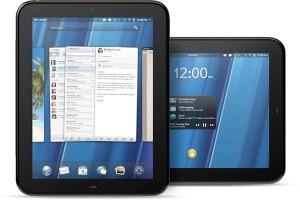HP TouchPad: a polished contender to the iPad
The world of tablets is getting downright crowded, with seemingly every tech company worth its salt looking to get a piece of the booming market launched last year by Apple’s iPad. The newest entry is Hewlett Packard’s TouchPad, which comes out in the United States on July 1 and in Canada and other countries on July 15.
 I’ve had a TouchPad for just over a week and have been comparing it to the other top three tablets available (iPad 2, Motorola Xoom and BlackBerry Playbook). Let’s start with a review of the TouchPad, with some thoughts on the other three following afterward.
I’ve had a TouchPad for just over a week and have been comparing it to the other top three tablets available (iPad 2, Motorola Xoom and BlackBerry Playbook). Let’s start with a review of the TouchPad, with some thoughts on the other three following afterward.
The basics: The TouchPad has a 9.7-inch display and runs webOS 3.0, the latest version of the web-based operating system developed by Palm, which HP acquired in 2010. It’s the same well-received OS that runs on Palm’s line of Pre smartphones. The tablet has one front-facing 1.3-megapixel camera, a light sensor, accelerometer, compass and gyroscope, with Bluetooth and Wi-Fi. It doesn’t have 3G but rumours suggest that might be coming later this year. The tablet also doesn’t have a GPS, but its map functions do work with Wi-Fi. Under the hood, the tablet packs a 1.2-gigaherz Snapdragon processor and comes with two storage options: the 16-gigabyte model is $499 in the U.S. while the 32GB one is $599. The Canadian versions sell for $519 and $619, respectively. Full specs can be found here.
The good: As with the Pre phones, the webOS is a slick operating system that makes handling the TouchPad fun. The tablet is capable of multitasking, which means it can run multiple applications at once, so you can have a video open while surfing the web at the same time. Open apps are represented by “cards,” which are similar to windows on a computer. Navigating between cards is done by flicking left and right, while closing an app is done by an upward flick off the screen, which I have to admit is quite fun.
One of the TouchPad’s strong points is its deep email app. The device aggregates multiple email accounts and displays them in three columns - the left-most displays accounts, the middle one shows headers from the account currently selected and the right-most shows the email. The size of the columns can be easily adjusted with swipes, so an individual email can be blown up to full screen. Emails can then be replied to and forwarded, printed wirelessly to an HP printer or filed into folders.
Typing on a touchscreen is never fun, but HP has tried to ease this by eliminating some unnecessary steps. The on-screen keyboard has a numbers row above the letter, for example, while the size of the keys can also be adjusted. These are some small, nice touches - no pun intended - that make typing a little easier.
The TouchPad also boasts a similar “Synergy” feature that aggregates contacts and information from across several apps into single points of reference. The chat app, for example, can pull in contacts from Skype, Google, Yahoo and other instant messaging services and display all of them in the same place. The photo app, meanwhile, aggregates pictures from the device itself and blends them with those in a Facebook, Photobucket or Snapfish accounts. These are all neat features that take a little getting used to, but once they’re mastered they save the user from having to constantly sign into and flip between different apps.
The tablet also has a powerful universal search function called “Just Type.” The feature not only looks into search engines and folders on the device, it can also comb supported apps and web sites. Rather than opening the web browser, going to Wikipedia and looking for a topic there, the site can be searched from the Just Type field on the home page.
Notifications are also handled nicely on the TouchPad. Rather than popping up in the middle of the screen and interrupting whatever it is you’re doing, like what happens on the iPad, notifications are stacked unobtrusively in a bar at the top of the screen. So, whenever you get an email or someone comments on your WordPress blog, a short line pops up to let you know. Touching the notification takes you to the relevant app while swiping gets rid of it.
The device also has a few accessories to go with it, sold separately, including a cover and a Bluetooth keyboard. The coolest is the Touchstone, a wireless charger similar to the one used by the Pre. The Touchstone charges the tablet through magnetic induction and activates exhibition mode, which can display a clock, calendar, photos or any other app that has such a function built in to it.
The bad: At 1.6 pounds, the TouchPad is fairly heavy. The iPad 2, billed as the lightest and thinnest, is 1.35 pounds, yet those extra grams seem to make a significant difference. The TouchPad feels bulky in comparison.
HP’s tablet is also somewhat slow at launching apps, particularly Word documents and the like through its Quickoffice feature. Apps usually take a second or so to open, which seems like a lifetime compared to the instant launches found on other tablets. It’s not a huge issue, but it does run counter to what has become the norm with such always-on devices.
While the TouchPad does have a forward-facing camera for video conferencing, it lacks the sort of outward-facing one that is now standard on rival tablets. Truth be told, the case for why tablets should have such cameras has yet to be made, but nevertheless, its absence seems like a potential limitation.
Where the TouchPad is limited is in the all-important apps category. Apple and Google’s Android boast hundreds of thousands of apps for their smartphones, with more and more of those being optimized for tablets every day. HP’s device is launching with about 6,200 Pre apps and about 300 tablet-optimized apps. Developers now have four major tablet operating systems to contend with, but they only have so much time and resources. Whether they can be lured to create apps for the TouchPad, not to mention Research In Motion’s PlayBook, remains to be seen. In HP’s defense, the company says one of the reasons it bought Palm was to get webOS, which is easy to create apps for because it is web-based.
There’s one other negative about the TouchPad and it’s something that all of the iPad’s rivals have been touting: Flash. Much has been made about Apple’s refusal to use the popular multimedia feature, which enables a good portion of the web’s video, on its mobile devices. Rivals, including HP, see this as a weakness and have played up their tablets’ ability to run Flash and therefore display all of the web. The only problem is, I have yet to see a tablet that can run Flash smoothly and reliably. Many of my efforts at doing so on the TouchPad resulted in the tablet crashing outright. While the iPad can’t run Flash, in this respect Apple has been right so far.
Final thoughts: The good outweighs the bad on the HP TouchPad and after an albeit short week or so of playing with it, it seems to be the second-most polished of the four major tablets available. The iPad 2, being a second-generation device, is obviously ahead of the curve and has all of the best apps, including a host of great games. Its inability to run Flash is looking like less and less of a weakness every day as more and more websites convert to HTML5, which is compatible with Apple’s mobile devices. As such, Apple’s dominance in tablets is sure to continue for the foreseeable future.
The Motorola Xoom packs impressive hardware, such as high-definition video output, and is well positioned to take advantage of Android apps as they inevitably become optimized for tablets. As it stands though, many of the apps that are available for it seem hastily assembled and aren’t much to look at. The same can be said for its overall haphazard organization - navigating through the tablet is a bit like looking for something in a messy teenager’s room. I’m sure Android tablets are going to get better and start taking market share from Apple, but the Xoom just doesn’t seem quite there yet.
The BlackBerry PlayBook similarly has great hardware, but it’s clearly still a work in progress. RIM has the same app challenges as HP, but its tablet still doesn’t have some basic, necessary functions, such as standalone email. The PlayBook is promising, but it needs a lot of fixing before it can be a contender.
The TouchPad is the first non-iPad tablet I’ve used that didn’t seem rushed out the door. It does have a few organizational and navigational advantages over the iPad, although I’m not sure these are enough to warrant picking it over Apple’s device. Nevertheless, it’s a nice start for HP.



Recent Comments